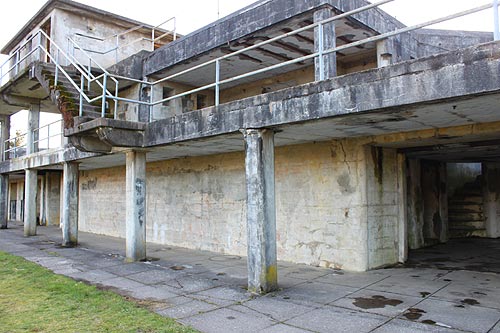Fort Stevens State Park: What's Really Underneath This Oregon Coast Historical Site
Updated Periodically
By Oregon Coast Beach Connection staff

(Warrenton, Oregon) – Up on the north Oregon coast, Fort Stevens State Park has more than just the obvious history. Striking, eye-popping and realtime examples of the past are sitting all around you: the wreck of the Peter Iredale, Battery Russell, and several other physical objects and buildings – including a whole other military complex only open some parts of the year.
Includes exclusive listings; some specials in winter
In Cannon Beach:
Includes rentals not listed anywhere else
In Manzanita, Wheeler, Rockaway Beach:
Some specials for winter
In Pacific City, Oceanside:
Some specials for winter
In Lincoln City:
Some specials for winter
In Depoe Bay, Gleneden Beach:
Some specials for winter
In Newport:
Look for some specials
In Waldport
Some specials for winter
In Yachats, Florence
Some specials for winter
What’s behind it and beneath it - geologically - is rather shocking, however.
Did you know that parts of Fort Stevens didn't exist before 100 years ago?
The building of jetties at the mouth of the Columbia River in the 1890's allowed a mindbogglingly large chunk of land to be created. Many of the ponds and wetlands you see along the road going to the south Jetty weren't there when Lewis & Clark wandered these shores.
According to one lidar map from north Oregon coast geologist Tom Horning, something like a half mile of shoreline around the western side of Fort Stevens were not there until after the building of the jetties. They were inadvertantly manmade.
Horning said the changes happened quite quickly. Within a few years a lot of sand and land were added to the area.
Yet the growth of the shoreline continued, with dunes building westward as much as 20 feet each year since the early days of the Columbia River jetties. This doesn’t mean the entire shoreline kept growing that much – but it’s helped.
Essentially, according to Horning, what’s happened is sand keeps getting shuttled down from the Columbia River. Construction of the jetties really pushed this along, but continuous dredging of the shipping channel also keeps the sediment flowing.
“This ebbtide delta has served as a large sediment reservoir for longshore currents to transport sand north and south to build coastal beaches,” Horning said.
It’s entirely possible all this shoreline growth along the north Oregon coast and southern Washington coast has ceased and may be degrading now. Climate change and higher storm surges are playing a part, but so is something else manmade.
Studies done by Oregon State University geologists have found that while so much has been lobbed onto the area by the changes in sediment and sand distribution, these areas are very vulnerable to erosion. Peter Ruggiero, a geology professor at OSU, wrote a paper several years ago that showed all this newly-created sections of shoreline are still not yet stable. Nature has not figured out if it's halted taking sand away or if it's still depositing more.
Beaches to the north and south have been affected to large degrees. Ruggiero has said that parts of the southern Washington coast may be more vulnerable to disappearing than farther south.
In explaining this, Horning mentions a “littoral cell,” which means the space between headlands. In this case, we’re talking about the 30-plus miles between Cape Disappointment in Washington and Tillamook Head by Seaside.
“The many dams on the Columbia and its tributaries have created sediment sinks that intercept river sediment, preventing it from reaching the Clatsop beaches,” Horning said. “This will cause the sediment budget of the littoral cell to reverse itself and begin to obtain sand by eroding beaches and dunes, rather than providing it via ocean currents and winds. This commonly understood hazard will most likely begin to reveal itself in the next 20 to 50 years, mostly during storm surges, when large surf coincides with monthly high tides. Rather than dunes prograding westward, they will eventually begin to retrograde eastward.”
In other words, like much of the Oregon coast and Washington coast, Fort Stevens too is looking at shrinking. Lodging in Astoria/Seaside - Where to eat - Astoria / Warrenton Maps and Virtual Tours
Cannon Beach Lodging
Nehalem Bay Lodgings
Manzanita Hotels, Lodging
Three Capes Lodging
Pacific City Hotels, Lodging
Lincoln City Lodging
Depoe Bay Lodging
Newport Lodging
Waldport Lodging
Yachats Lodging
Oregon Coast Vacation Rentals
Oregon Coast Lodging Specials



More About Oregon Coast hotels, lodging.....
More About Oregon Coast Restaurants, Dining.....
LATEST Related Oregon Coast Articles
The briefly-formed twister apparently never touched down. Weather
Highway 6 to Oregon Coast Declared an Emergency Situation by Washington County
The move will hopefully initiate federal assistance. Traffic. Tillamook, Portland, Hillsboro, Oceanside, Pacific City
State Parks Dept Wants Input on New Drone Rules for Inland Oregon, Coast
Public input: rules would affect where drones can take off, land. Safety
Freaky Cool Astronomy: Earth Just Reached Its Highest Speed of Year and Close...
A few surprises about winter, including why it's short. Sciences
N. Oregon Coast's Highway 6: Why It Was Abruptly Closed for the Day This Weekend
A new roadway arose with more sunken asphalt. Traffic
Waves 17 to 26 Ft Along Oregon Coast: Surf Advisories, Sneaker Waves
A good show from Washington southward but some deadly possibilities. Weather
Two Videos Show Different Angles on Near-Deadly Oregon Coast Wave
The incident from 2021 just surfaced, showing a wave knocking people around Cape Kiwanda. Weather. Safety
Oregon Coast Town Looks at Possibility of Life Out There with Yachats Event
Jan 11 at the Yachats Commons examines the moon Europa. Yachats events
Back to Oregon Coast
Contact Advertise on BeachConnection.net
All Content, unless otherwise attributed, copyright BeachConnection.net Unauthorized use or publication is not permitted


















































